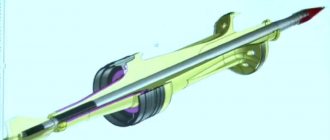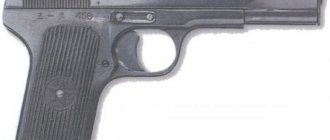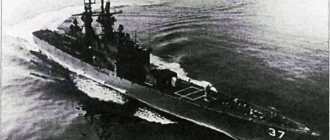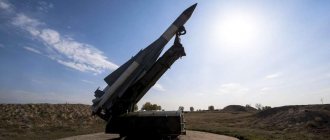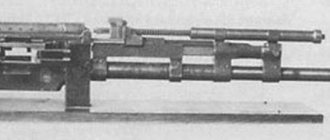| ◄ ► |
The subject is in action in the first millisecond.
Subject in action on the butthurt.
Railgun
(
rail gun
, English
railgun
, Ukrainian
reikova harmata
) is a promising funderwafer capable of shooting objects the size of a bearing [1] at distances from 30 to 200 km at speeds that even that mutant of yours, Mercury, will envy. The effectiveness of this prodigy, in theory, is many times greater than most common types of weapons.
[edit] And here it was not without the Nazis
Almost all firearms from ancient times to the present day use gunpowder to launch a projectile at a target: the gunpowder burns, causing the resulting gases to push the projectile out of the barrel. They began to think about using electricity to launch a projectile back in the bearded times of the 19th century. But only in 1902, the racial Frenchman Andre Louis-Octave Fauchon Vieple decided to obtain a patent for this type of weapon. The tests were carried out from 1916 to 1918, and due to either crookedness, or crankiness, or the lack of an ammeter, measurements of the current strength and initial velocity of the projectile were not carried out, and as a result, it was only possible to establish the very possibility of creating such a weapon. The Germans began the first real tests of such a super-gun during the Second World War. Tests carried out by the racial German Joachim Hänsler in a railway tunnel in Bavaria gave hope for the creation of a formidable electromagnetic weapon: the prototype gun accelerated a ten-gram aluminum pipette to Mach 4 or more, which began to give rise to wet erotic fantasies in the minds of the Luftwaffe command. Well, judge for yourself, my young friend: with such speed it was possible to reach the American fortresses organizing zerg rushes on Fatterland at any height, and without really bothering with advances[2]. And therefore, in view of the illusory prospect of being bullied, Hansler was given an order for a rail-mounted anti-aircraft gun, although capable of firing shells containing half a kilo of explosives, with an acceleration speed of 2000 m/s and a rate of fire of 10-15 rounds per minute. But they received a donut hole, due to the reasons stated below, the order was never completed, and the Wehrmacht soon gave up its life. As a result, the prototype was captured by the Americans, who appreciated the idea, saying: “Yoba, we also want this...”.
During the Cold War, similar work was carried out by the Soviet shadowy genius. Of course, all developments were strictly secret, but there were enough rumors until the collapse of the empire. Rashka, in turn, simply did not have the money to develop these weapons, and the project was curtailed for a long time. Now in Russia the development of this weapon has resumed, while in parallel there is a debate about the feasibility of introducing such weapons.
Patent No. 1370200 André Fachon-Villepleix
On July 31, 1917, the previously mentioned French inventor Fachon-Villepleit filed an application with the US Patent Office for an “Electric gun or apparatus for propelling projectiles forward” and on March 1, 1921 received patent No. 1370200 for this device. Structurally, the gun consisted of two parallel copper rails placed inside a barrel made of non-magnetic material. The barrel passed through the centers of several identical electromagnetic blocks (EMBs), placed along it at a certain interval. Each such block was an W-shaped core made of sheets of electrical steel, closed by a jumper made of the same material, with windings placed on the outer rods. The central rod had a gap in the center of the block, into which the gun barrel was placed. The feathered projectile was placed on the rails. When the device was turned on, the current from the positive pole of the constant voltage supply passed through the left rail, the projectile (from left to right), the right rail, the EMB switching contact, closed by the projectile wing, the EMB coils and returned to the negative pole of the power source. In this case, in the middle rod of the EMB, the magnetic induction vector has a direction from top to bottom. The interaction of this magnetic flux and the electric current flowing through the projectile creates a force applied to the projectile and directed away from us - the Ampere force (in accordance with the left-hand rule). Under the influence of this force, the projectile receives acceleration. After the projectile leaves the first EMB, its switching contact is turned off, and when the projectile approaches the second EMB, the switching contact of this block is turned on by the wing of the projectile, creating another force impulse, etc.
During World War II in Nazi Germany, the Fachon-Villeple idea was taken up by Joachim Hansler, an official at the Ministry of Armaments. In 1944, he designed and manufactured the LM-2 10mm cannon. During its tests, a 10-gram aluminum “shell” was accelerated to a speed of 1.08 km/s. Based on this development, the Luftwaffe prepared technical specifications for an electric anti-aircraft gun. The initial speed of a projectile containing 0.5 kg of explosives was required to be 2.0 km/s, and the rate of fire was to be 6–12 rounds/min. This gun did not have time to go into production - Germany suffered a crushing defeat under the attacks of the Allies. Subsequently, the prototype and design documentation fell into the hands of the American military. Based on the results of their tests in 1947, a conclusion was made: for the normal functioning of the gun, energy was required that could illuminate half of Chicago.
The results obtained from tests of Gauss and Hansler guns led to the fact that in 1957, scientists participating in a symposium on hyper-velocity strikes held by the US Air Force came to the following conclusion: “…. It is unlikely that electromagnetic gun technology will be successful in the near future."
However, despite the lack of serious practical results that meet the requirements of the military, many scientists and engineers did not agree with these conclusions and continued research into the creation of electromagnetic ballistic weapons.
[edit] Device
The essence™ in one scheme
| « | In short, we take two live conductors and short them | » |
| — Anonymous explains the essence of the railgun and electric welding | ||
The wunderwaffle consists of two parallel electrodes called rails. The accelerated projectile is also a conductor of electricity and is located between the rails. Closing the electrical circuit, the projectile acquires acceleration due to the Ampere force acting on a closed conductor carrying current. Among other things, this same force acts on the rails themselves, leading them to mutual repulsion.
Under certain conditions, the projectile heats up and burns out, turning into conductive plasma, which continues to accelerate. However, due to its instability, it quickly disintegrates. At the same time, we must not forget that the movement of plasma under the influence of the Lorentz force is possible only in an air or other gaseous medium not lower than a certain pressure. For example, in a vacuum, the plasma rail jumper moves in the direction opposite to the Lorentz force, which can kill the shooter.
When using projectiles that do not conduct electricity, an arc is ignited behind the projectile between the rails, and the projectile begins to accelerate along the rails. The acceleration mechanism in this case is different from the above: the Lorentz force presses the discharge towards the back of the projectile, which begins to burn/evaporate and ultimately sets it in motion.
[edit] Advantages and disadvantages
From the point of view of computer games, the railgun is a very promising and interesting weapon, but let's return to earth.
The railgun has only two advantages, but what are they:
- In front of cannon artillery there is theoretically unlimited projectile speed. Powder cannons have a theoretical projectile speed of maximum 2.5 km/s, but in practice it is about 2 km/s. Experimental but working Gauss guns have already reached 2.5 km/s. Hence the conclusion: a railgun makes sense only if it can accelerate the projectile significantly faster than 2.5 km/s.
- In front of the missiles, only free (compared to missiles) crowbar with wings and filling called “warhead” flies towards the enemy... which is also impossible to intercept (see point 1). And the intercepted wunderwaffle with flaps for 100,500 money nervously rots in the museum.
But the rail side has a little less than a lot of disadvantages. Let's look at some of them.
- Let the blank fly out at a speed of 5 km/s (less than that makes no sense, see above), then with a mass of 3 kilograms its energy will be 32.2 megajoules (with a mass of 10 kg, respectively, 125 megajoules [ SHIETO?
]).
With a barrel length of, say, 10 meters, the acceleration will be 250,000 m/s² or 25,000 g. And the pulse power should be 1.6 gigawatts
for a three-kilogram blank and 6.2
gigawatts
for a 10-kilogram one. This is the average power per pulse, the peak is even greater, and at 100% efficiency (the efficiency of military models is unknown, but significantly less than 100%). For a minute, 1 GW is the capacity of an average nuclear power unit. Therefore, we need some kind of clever thing that will accumulate this heap of energy, albeit from a source of significantly less power, and then very quickly release it in the form of electric current. Homemade railguns use a battery of capacitors, but for a military gun some special capacitors are needed, since household electrolytes have a high capacitance, and a fast pulse is not obtained. Cunning Russians use disposable piezoelectric generators for this purpose, but so far with varying success. - A consequence of high overloads is the difficulty of manufacturing guided projectiles, and the accuracy of firing unguided blanks over hundreds of kilometers comes down to “approximately in that direction.” However, this can be mitigated by using atomic shells instead of cast iron ingots (which was successfully used in gunpowder artillery).
- When fired, an electric arc is formed, which burns not only the projectile, but also the “rails” themselves, destroying the inner surface of the railgun barrel. Therefore, after several shots, the barrel has to be changed, which reduces the rate of fire and increases the cost of operating this wonderful weapon.
- The projectile must make electrical contact with the rails and have good electrical conductivity, just like the rails. Otherwise, the accumulated energy will not be pumped into the magnetic field, but will be released into heat, which at such powers leads to a big bad boom. Aluminum, copper, silver and gold conduct current well, but these are all soft metals (and the last two are also expensive, so they are not considered), and therefore the rails will wear out quickly. And something needs to be done about it. While they are cunningly fucking with oxygen-free copper coated with silver.
- Throwing an aluminum blank at an enemy is also not good - not only is the metal soft, it is also light, so it will be slowed down more strongly by the air. But this is solved in the following way: the field accelerates a caliber aluminum washer, which contains a sub-caliber tungsten (or, as an option, uranium) crowbar with wings, which already flies to the enemy with greetings and democracy.
In general, there are many disadvantages, but they all have the nature of engineering problems. The nerds are working on it.
Also, among the promising ebuilds, plans are being voiced to throw tungsten/uranium scraps from orbit. At the same time, no one promises to conduct direct fire - on the contrary, the duty of accumulating kinetic energy is performed by the orbital station spinning around the Earth at at least the first cosmic speed of OVER 28,000 km/h, into which it was previously loaded as uranium fuel (to power the ion engine, for example ), and uranium is hurling. According to PROFIT, they promise to take care of Kuzka’s mother and space
ensure accuracy, and screw the UN convention of 1953 for the reason “there is no transformation of one element/isotope into another”: tungsten scrap made from space debris at an orbital plant can still create a local Chelyabinsk meteorite at once, but not at altitude, but already when stuck into the ground.
Induction mass accelerator
In the same 60s and early 70s. last century in the USSR, Professor (since 1983) Vladimir Nikolaevich Bondaletov and his collaborators carried out a study of another type of accelerator - induction - using a capacitor bank as an energy source. When this battery is discharged, a pulsed magnetic field is excited through a stationary coil (inductor), inducing a current in the second moving coil (accelerated conductor). The interaction of the pulsed magnetic field of the inductor with the current induced in the conductor creates an accelerating force. When accelerating aluminum washers weighing 10–30 g in a pulsed magnetic field in air, velocities of more than 1 km/s were obtained when efficiency was achieved. 28–43% Later, in 1977, a flat ring conductor weighing 1–2 g was experimentally accelerated to 5 km/s when discharging a capacitor bank with a voltage of 30–40 kV onto a disposable single-turn inductor made of a copper bus with a cross-section of 6 × 1.4 mm, which, as As a rule, it exploded when discharged. This test was carried out at the All-Union Electrotechnical Institute in Moscow.
[edit] Application
Actually, shooting with a crowbar
. Actually, since ancient times, it has been the custom that weapons are produced for specific purposes and tasks. You can create all sorts of foundation waffles, but they go into mass production and use exactly those for which there are tasks. Now let’s try for a moment to imagine that anti-ship missiles with a range of 200 km or more, which are armed with almost every vessel built after 1980, are prohibited as a cheating technique, because “it’s not fair” and let’s figure out what this railgun of yours can do.
- Shoot from a ship on the ground. Well, they shot a blank weighing 10 kilograms at 100 km, it fell in someone’s backyard. What's next? Farted in a puddle. Conclusion: we need a normal warhead. And if you also move your head and take into account that as the range increases, the spread of projectiles increases, then you need not just a normal warhead, but also a correctable one. And creating an adjustable projectile with an adequate warhead that can withstand an overload of 30,000 g is a whole separate engineering task with crazy prices for projectiles.
- Shoot at other ships. Even if we have the sight of the Lord God himself and we have calculated everything down to the nanometer and hit the enemy ship, the shell will make two holes in the ship on each side. A sailor passing by will plug the hole he sees in the side with a rag, with which he scrubs the floor. Fail
- The high speed of the projectiles allows the railgun to be used as an air defense weapon. But if the projectiles are not guided, then a rate of fire is needed, and in order to achieve the required rate of fire (no, not the funny 5-6 rounds per minute from a 25 megawatt reactor) you need to have on board the ship a nuclear reactor comparable to some Sayano-Shushenskaya hydroelectric power station. And don’t forget about the wear and tear of the gun barrel.
Also, the railgun is very useful for shooting crowbars at tanks, because no amount of defense will help. You just have to first invent a portable thermonuclear reactor like the Terminator or some kind of portable power station with a capacity of 2-3 megawatts. And don’t forget about a truck with spare barrels for our “rail tank” with a team of blacks to quickly replace the barrel right on the battlefield, although organizing the replacement of burnt out guides is the easiest task. But without high-explosive fragmentation filling, our super-duper mega tank becomes very ineffective against infantry and when shooting at cover. As a result, at the sight of him, the mahra will show Fuck to the tankers, laugh and try to hit the ass with a grenade launcher without risking his own skin. And here the crap begins - a light projectile won’t fit a lot of explosives, which means the effect of its explosion will be zero point one, and with an increase in the mass of the explosive, the locomotive also increases the mass of the projectile, as well as the size of the mirage of the Sayano-Shushenskaya hydroelectric power station behind each such Ubertank (see the beginning of the article). Against the background of the above, homeric laughter is caused by media publications talking about the railgun as a weapon of retaliation to deter Russia from attacking the Baltic countries. This looks especially funny when American experts themselves talk about the unsuitability of the rail gun.
Electromagnetic pulse of a high-altitude nuclear explosion
The high-altitude tests began with the Americans, who on August 1, 1958 carried out the first explosion in the upper layers of the earth's atmosphere over Johnston Atoll in the North Pacific Ocean, 717 nautical miles from Honolulu (Hawaii). Launching from a launcher built on the atoll, the PGM-11A Redstone ballistic missile designed by Wernher von Braun raised a W-39 nuclear warhead to an altitude of 76.8 km. The charge had a power of 1.9 Mt in TNT equivalent. One of the results of these tests was the disruption of power supply in the Hawaiian Islands due to the effects of the electromagnetic pulse of a high-altitude nuclear explosion. Radio transmissions as far away as Australia were also disrupted. On August 12, a similar charge was lifted by an SS-51 rocket and detonated at an altitude of 42.98 km. These high-altitude explosions of powerful thermonuclear charges were intended to test the effectiveness of their use in missile defense (BMD). Immediately after this, in August–September 1958, the United States conducted a series of nuclear explosions directly in space.
A modified Tomahawk missile being launched from a ship during Operation Desert Storm
In 1959–1960 and until August 1, 1961, the USSR did not conduct nuclear tests, participating in a moratorium on nuclear testing together with the USA and Great Britain. Shortly after this moratorium was interrupted, on October 27, 1961, the Soviet Union carried out two tests, the purpose of which was to test the effect of high-altitude and space explosions on the operation of radio-electronic systems for detecting missile attacks and missile defense. Both nuclear warheads were delivered to the explosion site using R-12 ballistic missiles launched from the Kapustin Yar test site. Two charges were detonated above the center of the experimental missile defense system at the Sary-Shagan test site - one at a 300-kilometer altitude, the other at a 150-kilometer altitude.
The generation mechanism of the considered nuclear EMR is the conversion of a small fraction of nuclear energy into electromagnetic energy with a radio frequency spectrum, which is performed in several intermediate processes. The first of these is the production of gamma radiation during the explosion. This gamma ray then interacts with atmospheric gas molecules, producing electrons and positive ions. When charges separate, part of the gamma radiation energy is converted into the kinetic energy of electrons, and their flow causes a current, which is associated with the emission of electromagnetic energy.
High altitude nuclear explosion
It should be noted that at this time (early 60s of the last century) the quantitative characteristics of nuclear EMR were insufficiently measured due to the following reasons:
- firstly, there was no control and measuring equipment capable of recording extremely powerful electromagnetic radiation, existing in millionths of a second;
- secondly, the electronic equipment of that time used electric vacuum devices that were little susceptible to the effects of EMR, which reduced interest in its study.
The creation of semiconductor devices, and then integrated circuits, especially digital devices, and the widespread introduction of these means into radio-electronic equipment forced military specialists to reassess the threat of EMP. The greatest danger is the stage of EMR growth, at which, in accordance with the law of electromagnetic induction, due to the extremely rapid increase in the current pulse, the induced voltage in various circuits can reach significant values (up to thousands of volts).
When exposed to the considered pulse overvoltages on radio-electronic and electrical equipment, the following may be observed:
- breakdowns of pn junctions in semiconductor devices;
- breakdowns of vacuum and gas-filled gaps;
- melting and breaks of current-carrying paths and resistive elements, places of soldering (welding) of wires due to thermoelectrodynamic stresses;
- device malfunctions;
- breakdowns of insulating materials that are irreversible and lead to complete failure of products (capacitors, cables).
Since the beginning of the 70s. last century, the issues of protecting weapons and military equipment from EMP began to be considered by the defense ministries of the great powers as having the highest priority. It should be noted that the effect of EMP is not selective in nature, as a result of which military and civilian systems that are not direct or indirect targets of a nuclear attack will be subject to strong EMP effects during a nuclear attack on distant targets. And above all, the use of nuclear weapons from the point of view of human morality cannot be explained and justified.
A. D. Sakharov
Nevertheless, the effect of electromagnetic radiation turned out to be so effective that the question immediately arose: is it possible to create a “clean” non-nuclear electromagnetic EMP weapon that is selective in nature, and ensure its precise delivery to the area of the target being hit?
[edit] In Holy Pindosia
It was supposed to have a railgun on board, but it didn’t work out - the PR people crap themselves.
According to articles, PR and reviews on the Internet, the Zamvolt class wunderwaffle ships were planned to be made an instrument of retaliation against the totalitarian Russia and China at the same time. The absurdity is that in the wake of the frenzy in May 2016, there were rumors that the holy American “railgun” would protect the Baltic states from “Russian aggression.” Yes, yes, a railgun with dubious characteristics and dubious efficiency, which has not even been properly tested or tested in combat, is entrusted with the sacred mission of protecting the Baltic states from “Russian aggression.” This Zumwalt of yours was planned to be equipped with laser and electromagnetic guns, but the United States refused to produce them. As a result, Zumvolt received traditional missile and artillery systems, and such that they are acceptable only for working on bare-assed Papuans in African countries. At the same time, the remake looked quite pitiful, reminiscent of some unit from Red Alert
: an iron, in the center of which, like on a floating cosmodrome, a launch silo rises forlornly, from which, in turn, the warhead of a single rocket sticks out phimically.
In response to the railguns, someone scared the Americans with “secret developments” - floating, nuclear poop. The Americans didn’t realize what it was, but realized that it was shitposting in every sense, and the trolling was unsuccessful. Although the "dirty bomb" (radiation-only under-nucleus) problem still looms IRL, squeezing out money for radiation scanners and nuclear science.
[edit] In Rashka
Soviet capacitors for a railgun against the background of the President of the Russian Academy of Sciences
During the Cold War, the Soviet Union, along with the United States, carried out work on creating electromagnetic guns. In the mid-80s, in that country, Soviet scientists created a prototype of this wunderwaffle. The speed of the plastic projectile was approximately the size of a bottle cap and reached almost 10 km per second. Little is known about other achievements, because they are secret. After the collapse of the scoop, it is obvious that everything was covered with a copper basin, and, most likely, with a pussy.
After the PR, frenzy and sodomy of the American media about the Zumwalt and the railgun, Rashkin’s PR people also decided that they needed to make fun of themselves and talked about putting satellites into orbit using a railgun:
| Obtaining high speeds is associated with great difficulties. Our task is to obtain systems with high pressures and explore the Universe with their help. The second task is protection from high-speed cosmic bodies that pose a threat to us, including space debris, comets, etc. The next task is launching satellites into Earth orbit |
| Vladimir Fortov, President of the Russian Academy of Sciences. Read completely |
In the 90s, while the joint space program of the new Russia and the United States still represented something more or less intelligible, people were rushing around with another idea - the so-called. "cosmic tennis" The bottom line was that packs of standard balloon probes were to be packed into the accelerator, which the station was supposed to shoot from orbit on second space missions to other planets of the Solar System. The idea didn’t take off, because they decided that it was better to assemble and pack one full-fledged research module, which could easily fly on a rocket, than to shoot shellfish, for which, in addition, it was necessary to build and maintain a new space station.
Railgun by Richard Marshall
In 1977, Dr. Richard Marshall from New Zealand, Canadian doctoral student John Barber and other researchers connected this extremely powerful current source through an interface box to a 5 m long rail gun. At first, the generator could not supply the energy needed by the rail gun because the inductance of its power circuit, during the passage of the projectile in the gun barrel, the current did not have time to increase to its calculated value. To solve this problem, they proposed an improved rail gun, the diagram of which is shown in Fig. 3, where 1 is the inductor, 2 is the breech of the rail gun, 3 is the core, 4 is the arc initiator, 5 is the projectile, 6 is the key, 7 is the rail gun.
Figure 3
When connecting a unipolar generator accelerated to high speed to a rail gun and then turning on its excitation winding, the increasing current first flowed through the circuit “left breech rail 2 - core 3 - right breech rail 2” and accelerated the core to approximately 100 m/s. By the time core 3 approached the actual barrel of rail gun 7, the current through it had already reached the calculated value. After the core 3 flew over the entrance to the barrel of the rail gun 7 (shown by the dotted line in Fig. 3), the current was closed along the circuit “left rail of the breech 2 - core 3 - left rail of the gun 7 - arc initiator 4 - right rail of the gun 7 - right rail breech 2".
The arc initiator 4 was a copper foil glued to the rear wall of the projectile, which played the role of a fusible insert. 0.3 ms after applying voltage to it, the fuse-link burned out, turning into an electric plasma through which a current of hundreds of kiloamperes (k/A) flowed. The plasma rushed forward, pushing the projectile in front of it like a piston. At the end of the period of acceleration of the projectile, the key 6 was closed with an explosive cartridge, ensuring the dissipation of the energy stored in the inductor 1 and thereby preventing its dissipation in the form of a destructive arc at the muzzle of the gun.
Marshall, Barber and Rushleig managed to accelerate a mass of 3.3 g of polycarbonate to a speed of 5.9 km/s. The result was achieved with very moderate parameters of the electrical pulse (290 kA). After this experience, many scientists imagined that with this approach it would be possible to reduce the thermal limitations on obtaining high speeds.
[edit] Gauss cannon
Speaking about the railgun, one cannot fail to mention the Gauss Cannon, which some patients confuse with a railgun. Back in 1895, the racial Austrian, pioneer of astronautics Franz Geft thought: “What if you attract some piece of iron with a very strong magnet, and attract it so that the speed of this piece of iron will be comparable to the speed of a bullet?” and wrap everything up... Then it was a project for a coil electromagnetic gun designed to launch spacecraft to the Moon. In full accordance with Arnold's principle, the cannon was named after the gloomy Teutonic mathematician Karl Gauss, who did not stand anywhere near this cannon. In short, the essence is this: we take a solenoid, place a dielectric barrel inside, insert a ferromagnetic projectile into one of the ends of the barrel, and apply current to the solenoid. A magnetic field arises in the solenoid, which accelerates the projectile, “pulling” it inside the solenoid, after which we do not forget to sharply turn off the solenoid, because the projectile will remain inside the solenoid (at the ends of the projectile, poles are formed, oriented according to the poles of the coil, which is why after passage center of the solenoid, the projectile will begin to pull in the opposite direction). For greater power and speed, we use several solenoids in a row, turning each one on in turn.
Despite the apparent simplicity of the Gauss gun, it has many disadvantages, the main one of which is high energy consumption and low efficiency (1-7%), turning it into a completely unpromising weapon. Add to this the heavy weight and dimensions of the installation. Moreover, with an increase in projectile speed, the time of action of the magnetic field is significantly reduced, which leads to the need not only to turn on each subsequent coil of a multi-stage system in advance, but also to increase the power of its field in proportion to the reduction of this time. Typically, this “minor drawback” is often overlooked, since most homemade systems have either a small number of coils or insufficient projectile speed. In the 2000s, there were plans for some nanocoils that were lighter and had greater productivity due to the elimination of side currents, but since then nothing has been heard about them. Which, in general, is not surprising, considering who has headed RosNano all these years.
The second stage of development of electromagnetic ballistic weapons in the USA
After some time, interest in electromagnetic ballistic weapons in the United States was again revived by the army and navy. The Army needed a weapon that could be mounted on a ground vehicle and used to launch kinetic projectiles against armored vehicles. The Navy was interested in creating railguns that could fire tungsten projectiles at a speed of at least 2.5 km/s and hit targets at sea and on land at a distance of up to 500 km.
In mid-2006, Sandia National Laboratories (Albuquerque, New Mexico) announced that they had developed a ground vehicle-based non-linear targeting electromagnetic gun. The development of this gun was carried out in two versions, namely: the Gauss gun and the railgun. At the time of publication of the message, both options were in the configuration and manufacturing stage.
This project pursued the following goals:
- demonstrate the electromagnetic cannon's ability to fire conventional 122mm mortar ammunition;
- demonstrate a launch speed of 420 m/s to ensure the firing range of a projectile weighing 18 kg at 9 km, i.e. improve it by 30%.
The Gauss gun consists of 45 separate identical coils, each of which is powered by a separate electrical capacitance. These capacities are different: from 8.5 μF at the 1st stage to 0.8 μF at the 45th stage, and they are charged from 6 kV in the breech of the gun to 20 kV at the muzzle. Currents range from 65 to 95 kA through the coil. The rated current through a four-rail railgun is 1.8 MA (1.8 × 106 A).
Modified M-934 mortar shells (in special fittings) were developed and manufactured for both versions of the electromagnetic gun. The first tests were scheduled for the end of 2006.
In 2011, Sandia National Laboratories announced that it had mature coil-propelled electromagnetic technology and was ready to demonstrate an 81 mm mortar based on it for deployment on tactical ground vehicles. From this we can conclude that in 2006–2007. testing of electromagnetic technology for firing mortar shells ended positively.
In November 2009, San Diego, Calif., the primary manufacturer of the Predator unmanned aerial vehicle and developer of the electromagnetic catapult for aircraft carriers, conducted the first successful test of the Blitzer electromagnetic railgun (Figure 4). The muzzle velocity of this gun is M-5 (where M is the Mach number, named after the Austrian physicist Ernst Mach. It is the ratio of the local flow speed to the local speed of sound. This definition is often used in the characteristics of aircraft). The straight-line firing range is 7 km. In this gun, the fittings through which the working electric current flows move along the rails like a piston and push the projectile in front of it. The Blitzer gun fired several shots, remaining fully operational after testing.
Figure 4. Blitzer electromagnetic gun
In 2005, a Navy program was launched in the United States, the purpose of which is to create a new long-range weapons system for surface ships, based on the use of electrical energy and kinetic munitions. Damage to the enemy will be caused due to the kinetic energy of the “blank” flying at very high speed. The Americans assigned the motto to this project: “Velocitas Eradico,” which translated from Latin means: “Speed destroys.”
The use of an electromagnetic railgun as weapon systems for warships will solve several problems, namely:
- will eliminate the need to use explosives in shells and gunpowder in artillery shots;
- will reduce the volume of ammunition cellars (they will turn into warehouses for metal blanks);
- will make it possible to abandon explosives and gunpowder and increase the explosion and fire safety of ships.
In October 2006, at the test site of the US Navy Surface Weapons Research Center (Dahlgren, Virginia), a projectile weighing 3.2 kg was fired from a research railgun; the power of the shot was 8 MJ.
A year and a half later, on January 31, 2008, a similar 3.2-kilogram aluminum projectile was fired at the same place, hitting a metal tank filled with sand. The initial velocity of the projectile during the testing period was M-7, and the kinetic energy of the shot reached 10.6 MJ. In this case, a bank of capacitors with increased capacity was used.
In the second half of 2009, the Surface Ship Weapons Center in Dahlgren received a new railgun, created by specialists from the American branch of the British, with an estimated power of 32 MJ, and an initial projectile speed of up to M-8. Specialists developed a special battery of capacitors capable of storing 100 MJ of energy for this program.
On December 10, 2010, a rectangular steel bar weighing 10.4 kg was fired from this railgun (Fig. 5), the speed of which was about M-7. These tests proved that the 32-megajoule electromagnetic cannon was capable of theoretically sending a projectile weighing 10–15 kg to a range of 100–110 miles.
Figure 5. Railgun
The new weapon was planned to be installed on promising warships of the US Navy, including the Zumwalt project destroyers under construction, whose modular design and electric transmission were designed with an eye to promising railguns. Elmo Russell Zumwalt, for whom this type of destroyer is named, is the nineteenth chief of U.S. naval operations, having served in World War II, the Korean War, and the Vietnam War. The first destroyer of this project, USS Zumwalt (DDG-1000), has already been built, launched, and since December 2015 it has been undergoing sea trials and fine-tuning (Fig. 6). On May 20, 2016, this ship was transferred to the US Navy.
Figure 6. USS Zumwalt (DDG-1000)
In February 2011, the US Navy at the Surface Weapons Center in Dahlgren began testing an industrial prototype of a railgun created by. The company's new railgun is 12 m long, looks compact and suitable for placement on a destroyer or frigate class ship. Test firing is carried out with a shot energy of 32 MJ, and the projectile speed reaches 1600 m/s. It is also planned to test an industrial prototype of a railgun (Fig. 7), created by .
Figure 7. Industrial prototype of a railgun from General Atomics
The seriousness of the project is also evidenced by the fact that, in addition to the named companies, it was joined by the largest one, which produces guided missiles, radar systems, communication and control systems.
It was planned to install a railgun on the third ship of this series, USS Lyndon B.Johnson (DDG-1002), which was scheduled to enter service in 2022.
[edit] Why didn't it take off?
Despite the fact that in sci-fi the subject is actively being promoted as a kinetic weapon of the future, it is still not particularly in demand. The fact is that for modern gunpowder weapons there are no problems with either shot power or tightness. Even the Almaz turret—the first cannon to operate in space—was loaded with traditional percussion shells. Thus, the shot is more likely to rupture the barrel, tear off the turret or overturn the armor, than its power will not be enough for any task set in advance.
Another factor is energy sources. Nothing on some nuclear aircraft carriers or gas turbine tanks, but supplying each machine gun with a nuclear battery is an expensive and fraught pleasure. Don’t rush to bomb, anon - these lithium-ion ones of yours die quickly anyway, charging them in the field with large hemorrhoids, whenever possible, because, I guarantee, carrying ordinary horns while unloading is much less stressful.
Third, shooting in water is equally difficult for gunpowder and magnets. Plus the second one is much easier to short-circuit than the first one to become damp. So that!
Fourth. Undoubtedly, the exclusion of gunpowder and cartridges as components is a definite fault. To be fair, attempts to do this were made in Soviet prototypes. For example, a kerosene-powered machine gun was developed. It would have been successful as an air cannon (all from one tank), but, again, it would not have taken off in every sense. However, the advantage is not critical; in addition, there are also gunpowder caseless rifles, for example, the German G-11 (which also did not take off for a number of reasons).
The only niche in which a magnet currently seems indispensable is shooting plasma clots that cannot be dispersed in any other way. With this in mind, the concept has been developed since the 60s. The trouble is that Tesla’s balloons have remained a myth; the inventor certainly won’t teach you how to inflate them on your knee. Well, we’ll wait, Kagritsa, there’s no hurry.
Why a railgun?
Traditional artillery, the operating principle of which is based on the use of the energy of burning powder gases to throw a projectile, has been used by humanity for about 1000 years. Its capabilities have not yet been exhausted, however, the accelerated pace of development of military equipment after the industrial revolution makes it possible to see the limits of the development of this type of firearms.
It is associated with the capabilities of ballistic powders, which do not allow the projectile to be accelerated to speeds above 2.5 kilometers per second. Another significant limitation lies in the capabilities of gun barrels, which experience monstrous loads when fired. Modern metallurgy makes it possible to make barrels with a much longer service life and better characteristics than 40, 50, 100 years ago, but each improvement in characteristics costs more and more.
Research into new systems, including weapons based on new physical principles, which include the railgun, began in the developed countries of the world back in the 1970s, when the limits of the development of traditional artillery became obvious.
[edit] Notes
- although nothing prevents you from shooting objects up to 10 kg and even more
- True, in order to disable a bomber with one hit, you need to try VERY hard - the “stubs” returning to the airfields after anti-aircraft fire are proof of this
| [ + ] Railgun is the key to victory! | |||||||||||||||||||||||
| |||||||||||||||||||||||


